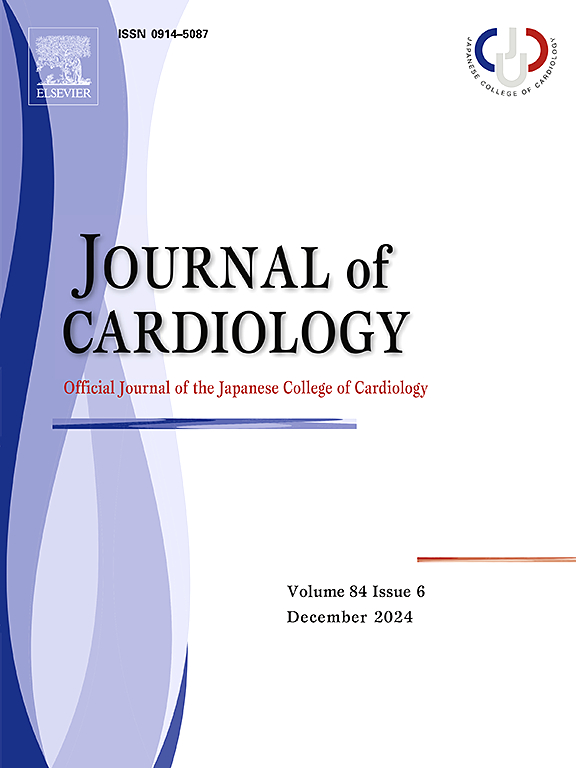在指南指导医疗时代,因心力衰竭住院的老年社区患者的临床疗效:COMPASS-HF 登记的启示。
IF 2.5
3区 医学
Q2 CARDIAC & CARDIOVASCULAR SYSTEMS
引用次数: 0
摘要
背景:尽管最新指南强烈建议在出院前实施指南指导下的药物治疗(GDMT),但有关老年心力衰竭(HF)患者的临床特征和预后的数据仍然缺乏。因此,本研究旨在调查 GDMT 时代超老龄化社会中心力衰竭患者的临床特征和预后:COMPASS-HF 研究包括 305 名连续住院患者,通过病历审查确定了 177 名急性心力衰竭患者。入组患者的平均年龄为 86.2 岁,46.3% 为男性。简单 GDMT 评分的平均值为 5.0,该评分被认为是日本心房颤动患者的有效预后工具。全因死亡和心房颤动住院的发生率分别为 46.5% 和 19.4%。简单 GDMT 高分组(≥5 分)的全因死亡和心血管死亡发生率明显低于简单 GDMT 低分组(≤4 分)(分别为 p = 0.049 和 p = 0.044)。然而,两组之间在心房颤动住院和复合事件(心血管死亡和心房颤动住院)方面无明显差异(分别为 p = 0.564 和 p = 0.086):虽然 GDMT 在老年社区实施得很好,但心房颤动住院患者的死亡率仍然很高。虽然 GDMT 似乎降低了心房颤动住院率,但进一步验证和开发针对老年心房颤动患者的最佳预测模型至关重要:在老年社区,虽然即使在 GDMT 时代,住院的心房颤动患者的短期和长期死亡率仍然很高,但心房颤动住院率却得到了抑制,这可能是 GDMT 的功劳。简单的 GDMT 评分也可用于对老年心房颤动患者的预后进行分层。#HeartFailure#死亡率#GDMT#神奇4。本文章由计算机程序翻译,如有差异,请以英文原文为准。

Clinical outcomes of patients from older community hospitalized for heart failure in guideline-directed medical therapy era: Insights from the COMPASS-HF registry
Background
Despite strong recommendations in the latest guidelines for implementing guideline-directed medical therapy (GDMT) before discharge, there is a lack of data on the clinical characteristics and outcomes of older patients with heart failure (HF). Therefore, this study aimed to investigate the clinical characteristics and outcomes of patients with HF in a super-aging society during the GDMT era.
Methods and Results
In the COMPASS-HF study including 305 consecutive hospitalized patients, 177 with acute HF were identified through a medical record review. The mean age of the enrolled patients was 86.2 years, and 46.3 % were men. The mean simple GDMT score, which is recognized as a useful prognostic tool for Japanese patients with HF, was 5.0. The incidences of all-cause death and HF hospitalization were 46.5 % and 19.4 %, respectively. The incidences of all-cause death and cardiovascular death were significantly lower in the high simple GDMT score group (≥5 points) than in the low simple GDMT score group (≤4 points) (p = 0.049 and p = 0.044, respectively). However, no significant differences were noted in HF hospitalization and composite events (cardiovascular death and HF hospitalization) between the groups (p = 0.564 and p = 0.086, respectively).
Conclusions
While GDMT was well-implemented in the older community, the mortality rate among hospitalized patients with HF remained high. Although GDMT appears to have reduced the HF hospitalization rate, further validation and development of an optimal predictive model for elderly patients with HF are essential.
X (formerly Twitter)
In the older community, although the short- and long-term mortality of hospitalized patients with HF is still high even in the GDMT era, the HF hospitalization rate is suppressed, probably due to GDMT. A simple GDMT score may also be useful for stratifying the prognosis of older patients with HF. #HeartFailure#Mortality#GDMT#Fantastic4.
求助全文
通过发布文献求助,成功后即可免费获取论文全文。
去求助
来源期刊

Journal of cardiology
CARDIAC & CARDIOVASCULAR SYSTEMS-
CiteScore
4.90
自引率
8.00%
发文量
202
审稿时长
29 days
期刊介绍:
The official journal of the Japanese College of Cardiology is an international, English language, peer-reviewed journal publishing the latest findings in cardiovascular medicine. Journal of Cardiology (JC) aims to publish the highest-quality material covering original basic and clinical research on all aspects of cardiovascular disease. Topics covered include ischemic heart disease, cardiomyopathy, valvular heart disease, vascular disease, hypertension, arrhythmia, congenital heart disease, pharmacological and non-pharmacological treatment, new diagnostic techniques, and cardiovascular imaging. JC also publishes a selection of review articles, clinical trials, short communications, and important messages and letters to the editor.
 求助内容:
求助内容: 应助结果提醒方式:
应助结果提醒方式:


